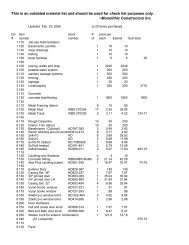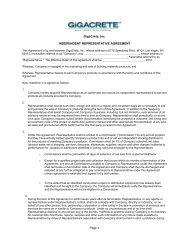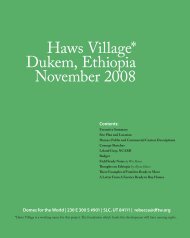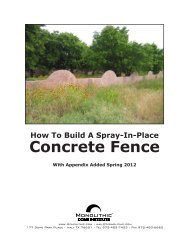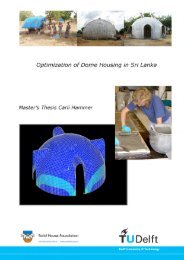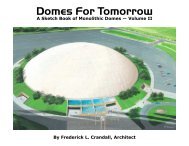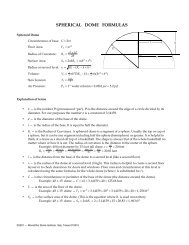Literature Review on Building Envelope, Heating and ... - Beeshive.org
Literature Review on Building Envelope, Heating and ... - Beeshive.org
Literature Review on Building Envelope, Heating and ... - Beeshive.org
Create successful ePaper yourself
Turn your PDF publications into a flip-book with our unique Google optimized e-Paper software.
Pier Foundati<strong>on</strong> System<br />
Brooks (2000) discussed the rati<strong>on</strong>ale for the pier foundati<strong>on</strong> for the above-surface<br />
facilities. Envir<strong>on</strong>mental c<strong>on</strong>diti<strong>on</strong>s in Antarctica’s n<strong>on</strong>-coastal locati<strong>on</strong>s pose significant<br />
challenges, <strong>and</strong> traditi<strong>on</strong>al c<strong>on</strong>structi<strong>on</strong> methods of cold regi<strong>on</strong>s are not adequate to cope<br />
with them. The main challenge is the annual snow accumulati<strong>on</strong>. With no frost cycle,<br />
snow accumulati<strong>on</strong> eventually buries structures built <strong>on</strong> the surface. Snow drifts, created<br />
by high winds, speed up the burial process. To overcome this envir<strong>on</strong>mental difficulty,<br />
the pier foundati<strong>on</strong> is used <strong>and</strong> buildings are initially c<strong>on</strong>structed 3 to 5 m (10 to 16 ft.)<br />
above the snow surface, often incorporating a means of periodically raising the building<br />
to remain above the snow accumulati<strong>on</strong>.<br />
Pier foundati<strong>on</strong>s also help in c<strong>on</strong>trolling snow drifting. The elevated structure allowed<br />
wind to channel below the structure, which effectively swept the snow away, eliminating<br />
the problem. Haugun (1991) reported a similar finding. Elevating the building above the<br />
ground by about 1.8 m (6 ft.) worked well in avoiding excessive snow accumulati<strong>on</strong><br />
around the building. Wind flow under the building kept the immediate area of the<br />
building clear of snow. Brooks (2000) also reviewed various pier foundati<strong>on</strong>s <strong>and</strong><br />
structure-jacking methods for other above-surface stati<strong>on</strong>s built <strong>on</strong> the interior ice shelf<br />
plateau in Antarctica.<br />
Stati<strong>on</strong> C<strong>on</strong>structi<strong>on</strong><br />
The US South Pole stati<strong>on</strong> c<strong>on</strong>sists of a row of 13 modular buildings elevated 3 m (10 ft.)<br />
above the surface <strong>on</strong> scaffold piping. Based <strong>on</strong> the results of wind-tunnel testing, the row<br />
of buildings was oriented at right angles to the prevailing wind <strong>and</strong> c<strong>on</strong>nected by a single<br />
walk covered by semicircular corrugated galvanized steel siding <strong>on</strong> the windward side.<br />
The visual effect is that of a C-shaped structure, rounded <strong>on</strong> the windward side <strong>and</strong><br />
squared <strong>on</strong> the leeward side.<br />
C<strong>on</strong>structi<strong>on</strong> Challenges<br />
Marty (1999, 2000, 2004) <strong>and</strong> R<strong>and</strong> <strong>and</strong> Brier (2000) discussed the c<strong>on</strong>structi<strong>on</strong> of the<br />
stati<strong>on</strong> that replaced the 1975 facility. The c<strong>on</strong>structi<strong>on</strong> started in 1997 with a planned<br />
completi<strong>on</strong> in 2007. When completed, the elevated facility will include new remote<br />
facilities, a communicati<strong>on</strong>s centre, garages, <strong>and</strong> shops. The design c<strong>on</strong>cept of the 1975<br />
as well as the 1957 facility was based <strong>on</strong> placing buildings within steel arches that could<br />
withst<strong>and</strong> burial <strong>and</strong> also within a dome structure. The c<strong>on</strong>cept of the new facility was<br />
based <strong>on</strong> a balance of below-surface <strong>and</strong> elevated structures. The existing steel arches are<br />
to be used for utilities <strong>and</strong> storage. The unique complexities <strong>and</strong> challenges of<br />
c<strong>on</strong>structi<strong>on</strong> particular to this antarctic locati<strong>on</strong> included the following.<br />
• Shortness of breath <strong>and</strong> headaches caused by altitude are comm<strong>on</strong>. The stati<strong>on</strong> is<br />
situated at 2852 m (9355 ft.) above sea level. In additi<strong>on</strong>, barometric pressure<br />
fluctuati<strong>on</strong>s create equivalent altitudes of 3424 m (11 235 ft.). Clothing weight limits<br />
dexterity <strong>and</strong> work efficiency. The average weight of clothing is about 16 kg (35 lbs).<br />
Climate c<strong>on</strong>diti<strong>on</strong>s include a mean temperature of -49ºC (-56ºF) in summer <strong>and</strong> -62ºC<br />
(-80ºF) in winter. Wind chill can lower average temperatures to -57ºC (-70ºF) in<br />
summer <strong>and</strong> -73ºC (-100ºF) in winter.<br />
PERD-079: Task 2 - <str<strong>on</strong>g>Literature</str<strong>on</strong>g> <str<strong>on</strong>g>Review</str<strong>on</strong>g> 53



